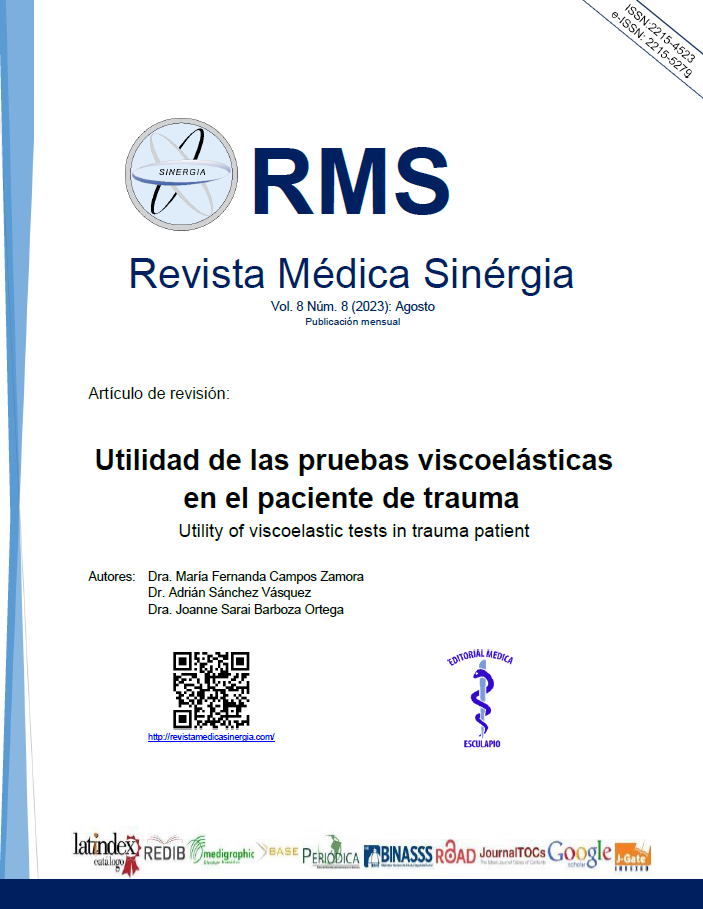Abstract
Trauma-induced coagulopathy is a complication suffered by polytraumatized patients with severe injuries, causing intense bleeding early, and thrombotic alterations in its late phase. It is a pathology that must be recognized quickly, and give a targeted treatment at the phases of the coagulation process in which the problem occurs, otherwise the patient has a high probability of dying. Viscoelastic tests are a hematological type test, in which a graphic type assessment of coagulation is made, providing real-time information on the patient's hemostatic state in a kinetic, sequential manner and includes dynamic changes that may arise during the process. It provides a very fast report compared to conventional coagulation tests, and facilitates the individualized choice of blood components to be transfused. With this review, it´s shown the usefulness of viscoelastic tests in the approach to a polytraumatized patient, because it makes it easier for the physician to make decisions on resuscitation of the patient quickly and safely, achieving adequate stabilization and finally avoiding complications.
Keywords
References
Kutcher M, Cohen M. Coagulopathy in trauma patients. UpToDate [Internet]. 2022 [citado el 23 enero 2023]. Disponible en: https://www.uptodate.com/contents/coagulopathy-in-trauma-patients
Sepúlveda P, Salgado A, Barriga J, et al. Utilidad del tromboelastograma en pediatría: Correlación con pruebas habituales de la coagulación. Rev. Chil. Pediatr [Internet]. 2019 [citado el 15 diciembre 2022];90(6). DOI: 10.32641/rchped.v90i6.930. Disponible en: https://www.revistachilenadepediatria.cl/index.php/rchped/article/view/930/1223
Zhu Z, Yu Y, Hong K, et al. Utility of viscoelastic hemostatic assay to guide hemostatic resuscitation in trauma patients: a systematic review. World Journal of Emergency Surgery [Internet]. 2022 [citado el 23 enero 2023];17(48). Disponible en: https://wjes.biomedcentral.com/articles/10.1186/s13017-022-00454-8
Sumislawki J, Christie A, Kornblith L, et al. The American Journal of Surgery [Internet]. 2019 [citado el 15 diciembre 2022];217(6):1037-1041. DOI: 10.1016/j.amjsurg.2019.01.014. Disponible en: https://www.sciencedirect.com/science/article/abs/pii/S0002961018304124
Keeffe T. Coagulopatía en el paciente en estado crítico. En Cameron J, editor. Terapias Quirúrgicas Actuales. Ed 13. España: Elsevier; 2021. p. 1251-1259.
Sayce A, Neal M, Leeper C. Viscoelastic monitoring in trauma resuscitation. The Journal of AABB [Internet]. 2020 [citado el 15 diciembre 2022]; 60:33-51. DOI: 10.1111/trf.16074. Disponible en: https://onlinelibrary.wiley.com/doi/10.1111/trf.16074
Taylor J, Cotton B. Problemas de coagulación en el paciente traumatizado. En: Cameron J, editor. Terapias Quirúrgicas Actuales. 13 ed. España; Elsevier; 2021. p. 1251-1259.
Harrison P, Lowe G. Platelet function testing. UpToDate [Internet]. 2022 [citado el 23 enero 2023]. Disponible en: https://www.uptodate.com/contents/platelet-function-testing
Martínez J, Petrone P, Axelrad A, et al. Comparación entre tromboelastografía y test de coagulación convencionales: ¿deberíamos abandonar los test de coagulación convencional en el paciente politraumatizado?. Cirugía Española [Internet]. 2018 [citado el 15 diciembre 2022];96(7):443-449. DOI: 10.1016/j.ciresp.2018.04.003. Disponible en: https://www.sciencedirect.com/science/article/abs/pii/S0009739X18301180
Moore H, Gonzalez E, Moore E. Trauma.Induced Coagulopathy. En: Moore E, Feliciano D, Mattox K, editors. Trauma. Ed. 8. Madrid: Mc Graw-Hill Education; 2017. p. 215-239.
Saydi J, Aribindi V, Todd R. Surgical Critical Care. En: Townsend C, Beauchamp D, Evers M, Mattox K, editors. Sabiston Tratado de Cirugía. Ed. 21. Barcelona: Elsevier; 2022. p. 521- 545.
Cannon J. Hemorrhagic Shock. The New England Journal of Medicine [Internet]. 2018 [citado el 15 diciembre 2022];378(4):370-379. DOI: 10.1056/NEJMra1705649. Disponible en: https://www.nejm.org/doi/full/10.1056/nejmra1705649
Schmidt A, Israel A, Refaai M. The utility of thromboelastography to guide blood product transfusion. Am J Clin Pathol [Internet]. 2019 [citado el 15 diciembre 2022];XX:1-16. DOI: 10.1093/AJCP/AQZ074. Disponible en: https://academic.oup.com/ajcp/article/152/4/407/5526928
Prasad P. Hemorrhagic Shock. Dynamed [Internet]. 2023 [citado el 27 enero 2022]. Disponible en: https://www.dynamed.com/condition/hemorrhagic-shock/about
Molina J, Delgado N, Leal S. Principales alteraciones de la hemostasia en el paciente crítico. En: Cárdenas A, Guiseris J, editores. Tratado de Medicina Intensiva. Ed. 2. España: 2022. p. 564-571.
Grossman S. Trastornos de la hemostasia. En: Grossman S, Porth C, editors. Fisiopatología. Ed 9. Barcelona: Wolters Kluwer; 2014. p. 648-664.
Peng H, Nascimento B, Tien H, et al. A comparative study of viscoelastic hemostatic assays and conventional coagulation tests in trauma patients receiving fibrinogen concentrate. Clinica Chimica Acta [Internet]. 2019 [citado el 15 diciembre 2022];495:253-262. DOI: 10.1016/j.cca.2019.04.066. Disponible en: https://www.sciencedirect.com/science/article/abs/pii/S0009898119318169
Baksaas-Aasen K, Van Dieren S, Balvers K, et al. Data-driven Development of ROTEM and TEG Algorithms for the Management of Trauma Hemorrhage. Annals of Surgey [Internet]. 2018 [citado el 15 diciembre 2022];XX(XX):1-8. DOI: 10.1097/SLA.0000000000002825. Disponible en: https://journals.lww.com/annalsofsurgery/Abstract/2019/12000/Data_driven_Development_of_ROTEM_and_TEG.36.aspx
Pressly M, Parker R, Neal M, et al. Accelerating availability of clinically-relevant parameter estimates from thromboelastogram point-of-care device. Trauma Acute Care Surg [Internet]. 2019 [citado el 15 diciembre 2022];88(5):654-660. DOI: 10.1097/TA.0000000000002608. Disponible en: https://journals.lww.com/jtrauma/Abstract/2020/05000/Accelerating_availability_of_clinically_relevant.11.aspx
Davidson J, Rahim S, Hanks S, et al. Society of Interventional Radiology Consensus Guidelines for the Periprocedural Management of Thrombotic and Bleeding Risk in Patients Undergoing Percutaneous Image-Guided Interventions—Part I: Review of Anticoagulation Agents and Clinical Considerations. J Vasc Radiol [Internet]. 2019 [citado el 15 diciembre 2022];30:1155-1167. DOI: 10.1016/j.jvir.2019.04.016. Disponible en: https://www.jvir.org/article/S1051-0443(19)30406-3/fulltext
Ziegler B, Voelckel W, Zipperle J, et al. Comparison between the new fully automated viscoelastic coagulation analysers TEG 6s and ROTEM Sigma in trauma patients. Eur J Anaesthesiol [Internet]. 2019 [citado el 15 diciembre 2022];36:834-842. DOI: 10.1097/EJA.0000000000001032. Disponible en: https://journals.lww.com/ejanaesthesiology/Fulltext/2019/11000/Comparison_between_the_new_fully_automated.6.aspx
Peng H, Nascimento B, Beckett A. Thromboelastography and Thromboelastometry in Assessment of Fibrinogen Deficiency and Prediction for Transfusion Requirement: A Descriptive Review. Hindawi [Internet]. 2018 [citado el 15 diciembre 2022];2018:1-25. DOI: 10.1155/2018/7020539. Disponible en: https://www.hindawi.com/journals/bmri/2018/7020539/
Juffermans N, Wirtz M, Balvers K, et al. Towards patient-specific management of trauma hemorrhage: the effect of resuscitation therapy on parameters of thromboelastrometry. Journal of Thrombosis and Haemostasis [Internet]. 2019 [citado el 15 diciembre 2022];17:441-448. DOI: 10.1111/jth.14378. Disponible en: https://onlinelibrary.wiley.com/doi/full/10.1111/jth.14378
Baksaas-Aasen K, Gall L, Stensballe J, et al. Viscoelastic haemostatic assay augmented protocols for major trauma haemorrhage (ITACTIC): a randomized, controlled trial. Intensive Care Med [Internet]. 2020 [citado el 15 diciembre 2022];47(1):49-59. DOI: 10.1007/s00134-020-06266-1. Disponible en: https://link.springer.com/article/10.1007/s00134-020-06266-1

This work is licensed under a Creative Commons Attribution-NonCommercial 4.0 International License.
Copyright (c) 2023 Array


